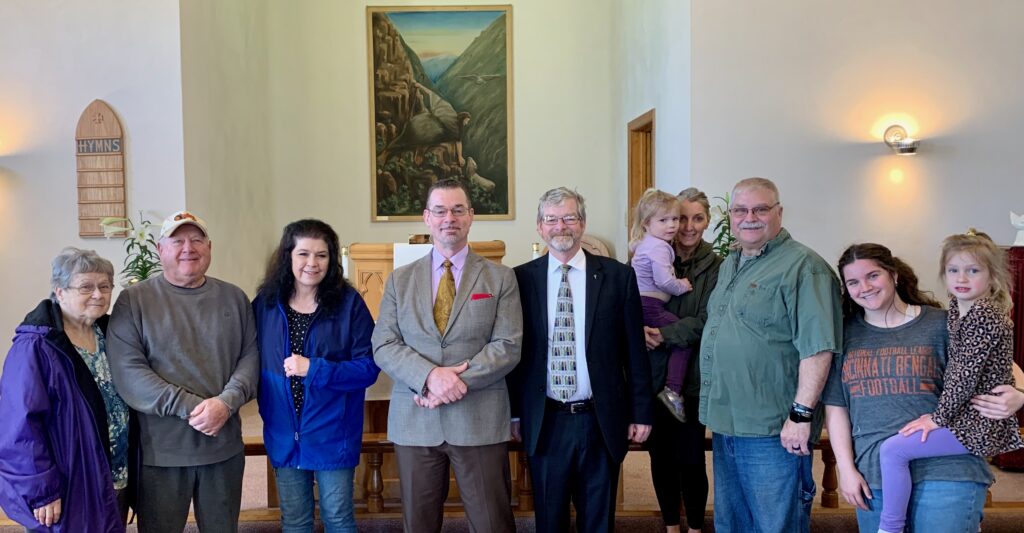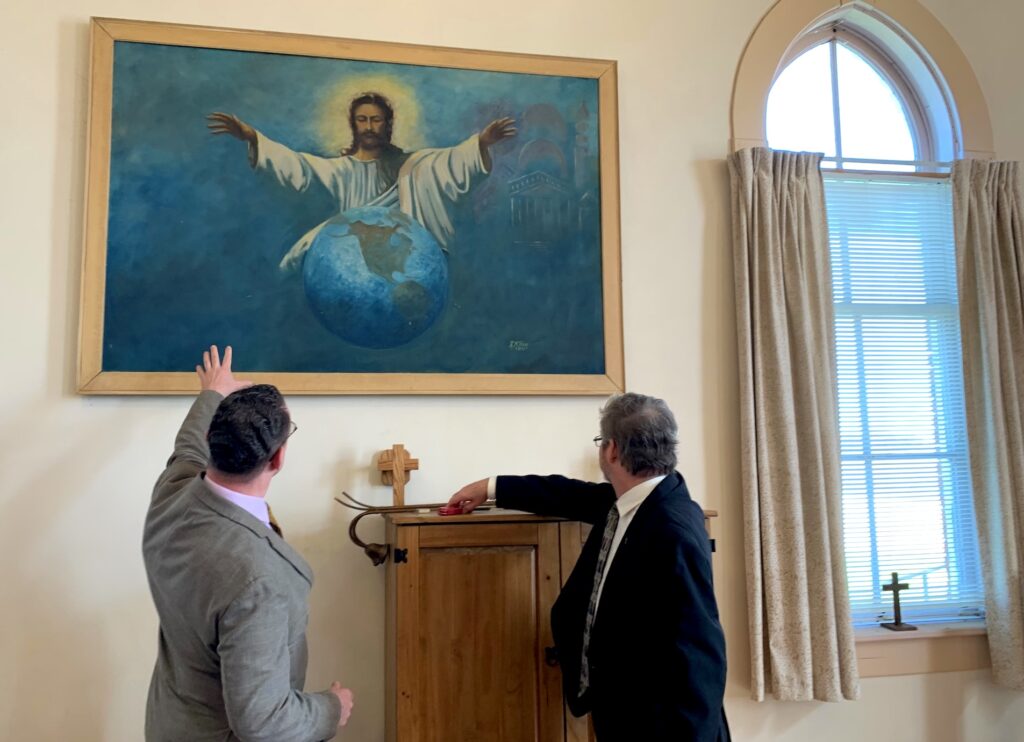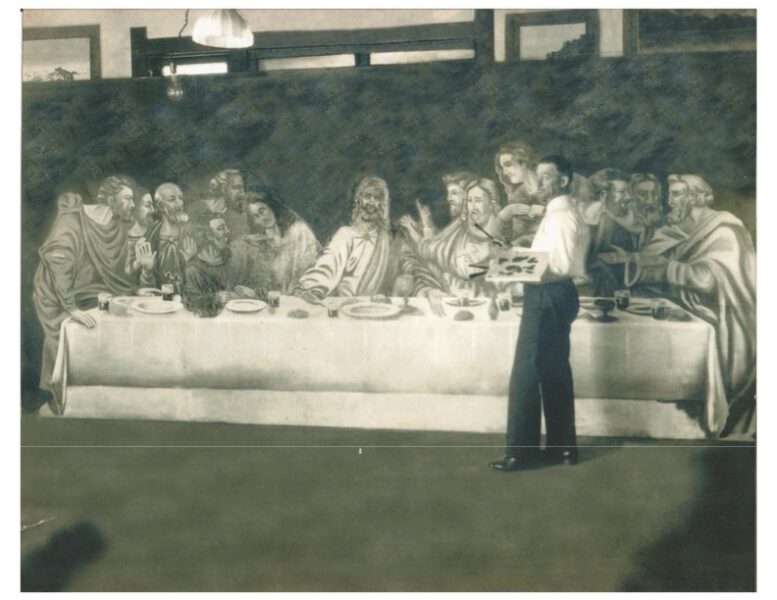By JULIE CARLE
BG Independent News
RUDOLPH —Every week, when Doug Kale and his family attend church at South Liberty United Methodist Church, he looks at a magnificent oil painting in the alcove behind the altar. He never questioned it or a similar painting on the back wall until the church received an email asking if they still had two paintings donated by Robert M. Wood.
The email came from brothers Dr. Richard Voss and Roger Voss of Alabama whose grandfather was the painter—Robert Mellalieu Wood. Though Wood died in 1956 before they were born, they knew a little about his colorful adventures from family lore from their mother Peggy Lenore Wood Voss, who was one of Wood’s four children with his wife Evelyn Germinnia May McBride. Richard’s recent delving into the family genealogy indicated Wood’s legacy was also part of Wood County lore.
Richard found clues of Wood’s life in Bowling Green in several online archived newspaper articles, that previously had not been easily accessible. The short stories he found connected Wood to two local United Brethren (now United Methodist) churches—South Liberty at the corner of Potter and Bays roads, and Trinity on North Summit Street across from the Wood County Courthouse.
According to the news articles from the 1930s, Wood was a local artist and musician who painted and donated two paintings each to the two churches. When the grandsons learned that the South Liberty church still had two of their grandfather’s paintings, they decided it was time for a road trip to northwest Ohio.
“We grew up seeing some of his smaller paintings of seascapes and portraits” that were still in the family, Richard said, “But we wanted to see these unknown, long-lost paintings for ourselves.” They also wanted to search for “The Last Supper” and “Christ Crucified Afresh” that Wood reportedly donated to Trinity.

Viewing the paintings at South Liberty United Methodist church on April 13 was almost surreal for the brothers. Neither of them is a painter, but they marveled at Wood’s talents and artistic vision.
The details of Jesus reaching for a lamb in “The Seeking Shepherd” caught Roger’s attention. The craggy cliffs that Jesus stands on with his staff and the subtle appearance of two blood-stained teardrops on the lamb’s face were elements that intrigued him. The approximately 6-foot by 4-foot painting was unveiled at the church on Nov. 8, 1931.
The second painting “The Savior Protecting the World,” was unveiled in September 1932, during a Wood County United Brethren Brotherhood meeting. The painting was presented to the South Liberty church as a reward for having the highest percentage of representation at brotherhood meetings during the previous year.
Richard and Roger admired the similar-sized oil painting that depicted Christ standing above the Earth that looks over the sanctuary from the back.
“I’m blown way how he captured the deep blue (of the sky) and Christ’s halo as the light of the world as he looks down on the Earth,” Roger said. “Seeing it in person, the foggy family lore comes to life.

“It’s good to see Granddad’s work up close,” Richard said, noting the precision of his grandfather’s signature on the paintings. These two paintings were signed “RM Wood,” though he often signed his work with “That Man Wood,” which was even referenced in his 1956 obituary.
None of the current parishioners or Pastor Charlene Miller was aware of the origins of either painting. Apparently, the members in the 1930s when the congregation was about 150 members strong had not passed along the history of the paintings to the current, much smaller fellowship.
“We are proud to have these paintings still in our church and to know we have been good stewards of them,” Miller said.
Kale and his family, Miller, Beth and Ron Nagel, and Larry and Esther Heilman were on hand to meet the grandsons and hear more about the paintings and the man who created them.
Sharing the story of ‘That Man Wood’
The Voss brothers were happy to share more about their grandfather who came to Bowling Green in about 1928.
Robert Mellalieu Wood was born April 30, 1885, in Hays City, Kansas, to Thomas Hart Benton Wood and Margaret Spencer Wood. His unusual middle name came from his maternal aunt’s husband, Robert Mellalieu, a newspaper editor from Lancashire, England.
The family moved to Denver in 1890, where Wood remained until the 1920s.
During the 1920s, “he rode the rails like a hobo, even when setting out to study under renowned artists George Graham of Cheyenne, Wyoming, and David Swing of Phoenix, Arizona,” and eventually to Bowling Green where he studied under Theodore Keane, Richard said.
According to the website askART.com, Keane had an art school in the Toledo area and lived on a farm near Custar.
Wood was “weirdly resourceful, learning radical resourcefulness from his father. He accomplished as much as possible without having to spend any money,” Richard said.
Wherever he went, he would find a business that would agree to grant him some space on the premises in exchange for unlimited sign painting. In Bowling Green, he worked out an arrangement with the company that occupied the land where the Wood County District Public Library is today.
“He also lived there, likely in the basement, just as his father had done previously with the family in Denver, effectively evading the census by residing in a nonstandard residence,” Richard explained.
On May 30, 1930, in the Trinity United Brethren Church, the Rev. Edward J. Haldeman presided over Wood’s wedding to a much younger Evelyn Germinnia May McBride. They had four children, including the Voss brothers’ mother Peggy Lenore Wood, and Thomas Benton Wood, Wanda Lynette Wood and Eunice Frances Wood.
Piecing together other aspects of Wood’s life from additional news articles, Wood was the choir director at the Trinity Church and taught percussion, drums, bells, xylophone, and tympani at the Gene Eichar School of Music and Dance at 142 N. Main St. (over what was the Wiggins & Gillespie Store. He also ran an indoor golf course and later used some of the golf course background decor to redecorate a building on the west side of North Main Street near Oak for a new implement firm.
“The Great Depression took a big toll on Wood’s life, causing increasing family strife in the later 1930s,” Richard said. Robert and Evelyn eventually divorced, and she remarried. He moved to Toledo to establish another sign-painting business by negotiating space with a company across from the Toledo Blade Building.
He died May 12, 1956, in Toledo, but is buried in Oak Grove Cemetery in Bowling Green with the epitaph “That Man Wood.”
Still searching for ‘The Last Supper’—Wood’s ‘holy grail’
Wood’s grandsons were thrilled to see the paintings their grandfather had brushed on canvas still on display at the small, brick country church.
They hope they might uncover some additional paintings by sharing the story of Robert Mellalieu Wood and his prolific artistic career in northwest Ohio. They are aware of the two paintings he unveiled at Trinity United Brethren Church on April 27, 1930, and April 23, 1933.
The massive 9 x 18 feet painting that is a reproduction of DaVinci’s “The Last Supper” is the one they are most interested in finding. The Voss brothers found a picture of their grandfather working on the unfinished artwork for the painting. When they reached out to Trinity United Methodist Church, before their trip to the area, they were told the painting was no longer in the church. It may have been given to another church or organization when the church did a major renovation in the 1950s. They are hoping someone might have a clue on its whereabouts.
At the time the finished painting was shown and donated to the Trinity church, the news article described the event:
“A very impressive service was witnessed and enjoyed by a crowd of about 600 last night when the large picture of “The Last Supper,” a copy of DaVinci’s by Robert Wood, an artist of this city was unveiled in the United Brethren church.
“The ceremony took place after the regular sermon and was conducted by Rev. E. . Haldeman of the church. The audience was highly impressed by the beauty of the picture and the accuracy of its reproduction of the original.”
“To us, ‘The Last Supper’ is the holy grail,” Richard said. “We hope this find (at the South Liberty church) will lead us to it. Northwest Ohio will become a family pilgrimage point to connect us to the grandfather we never knew.”





